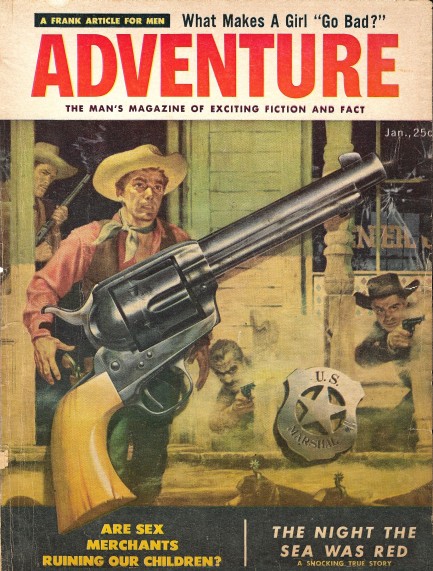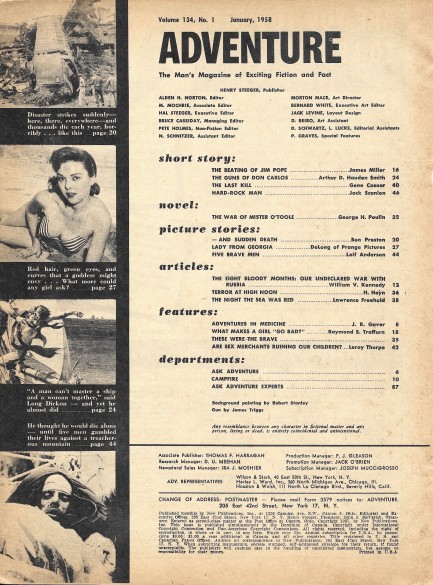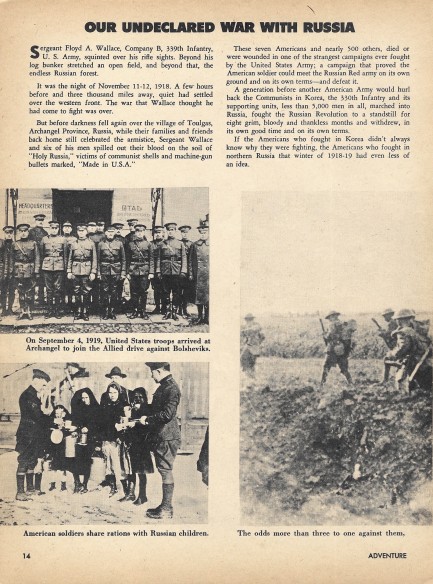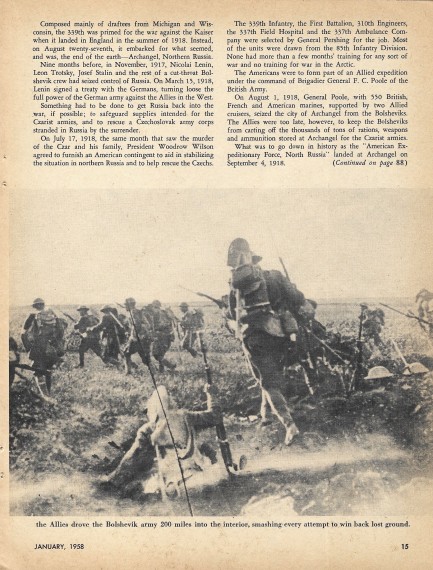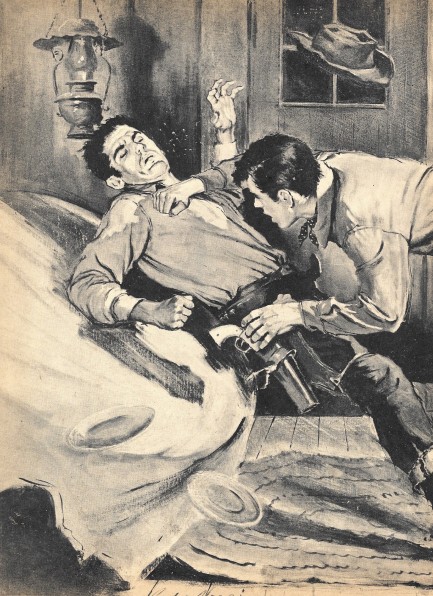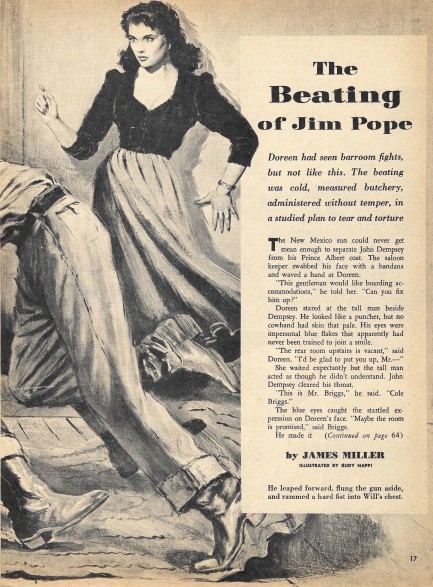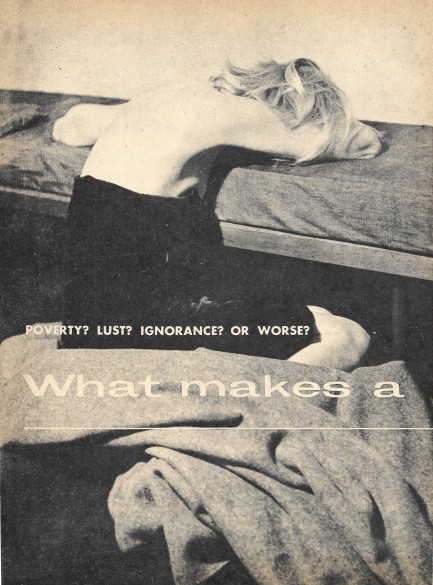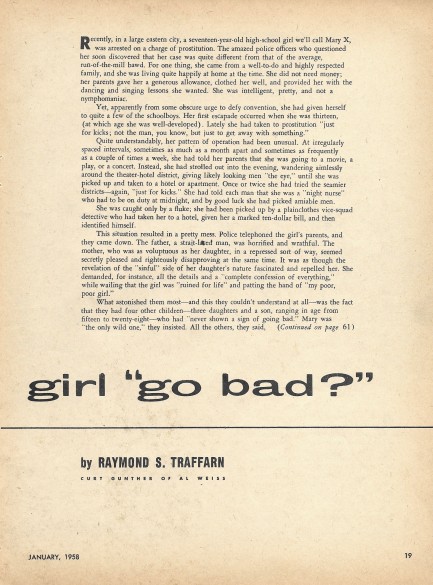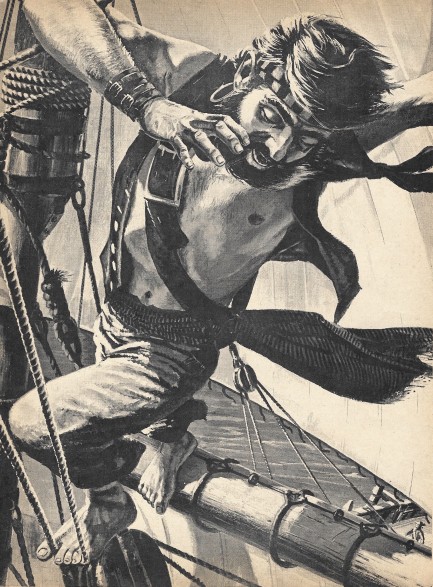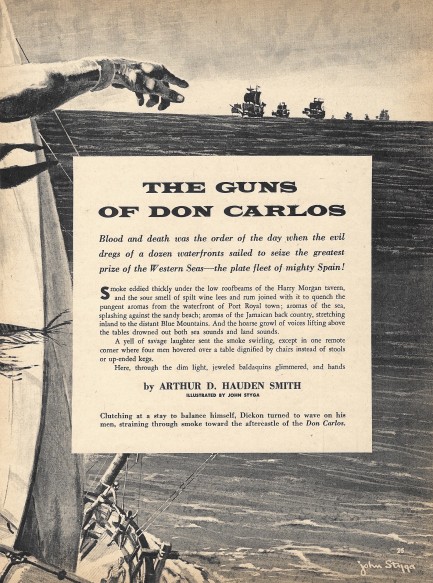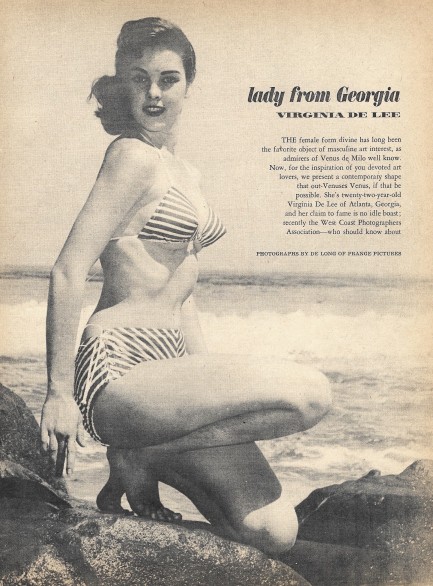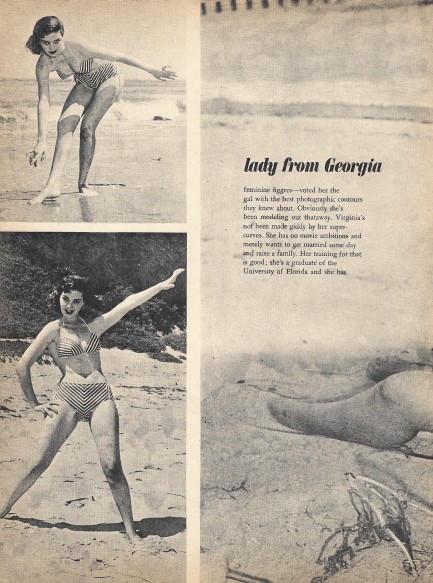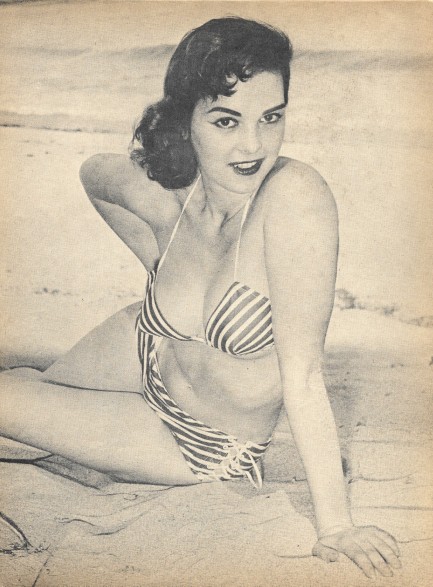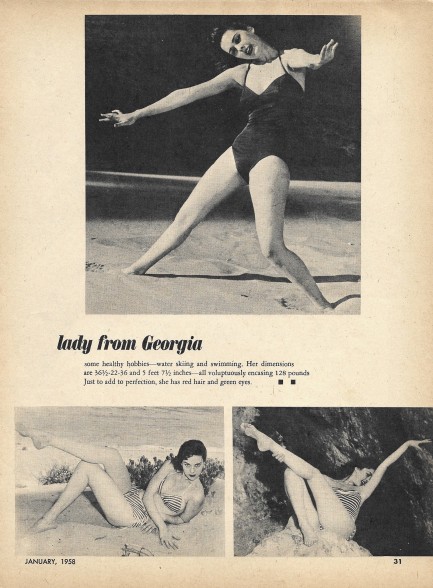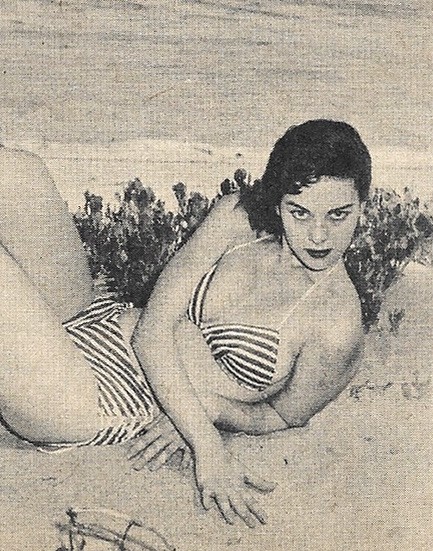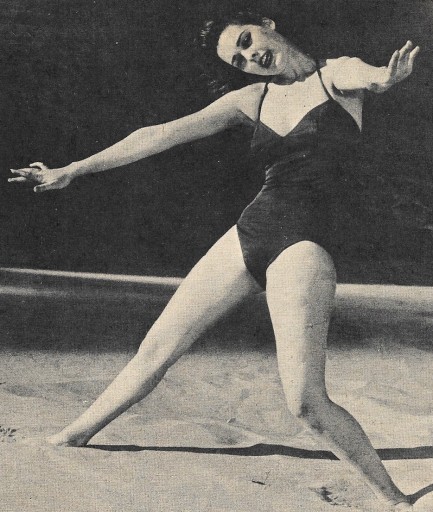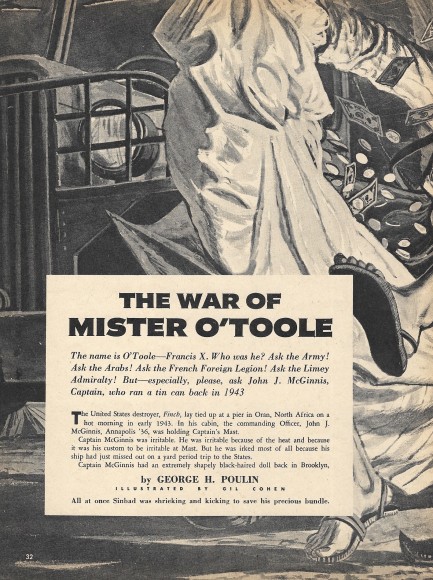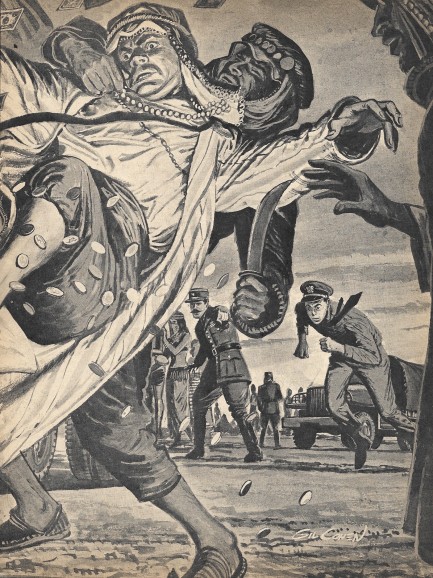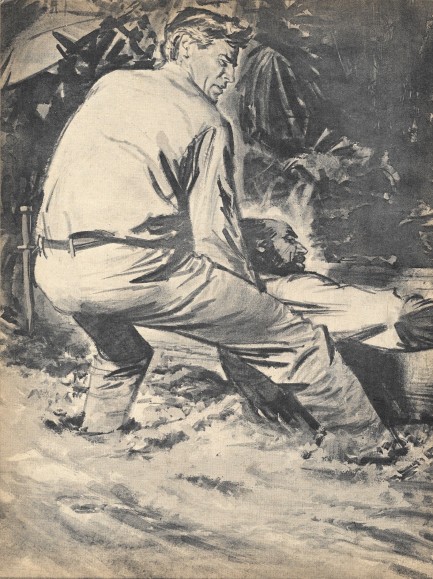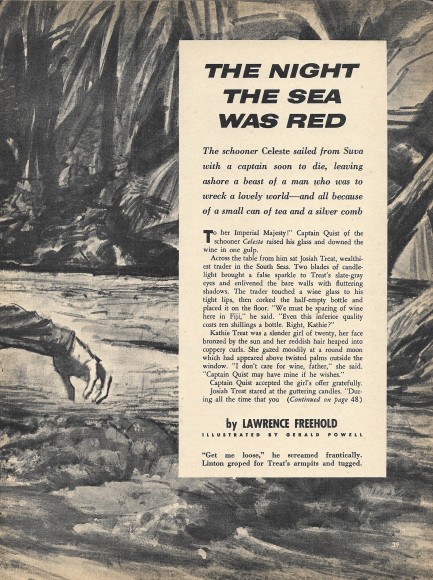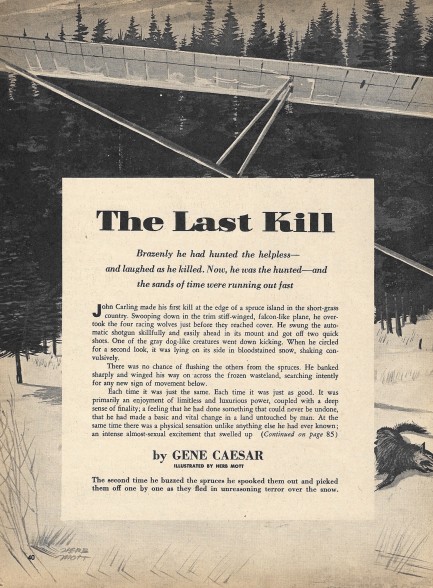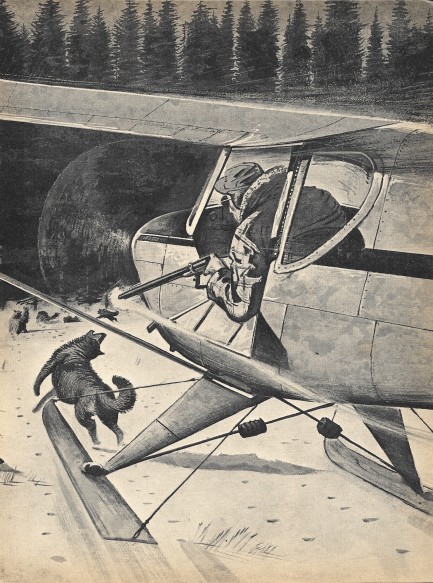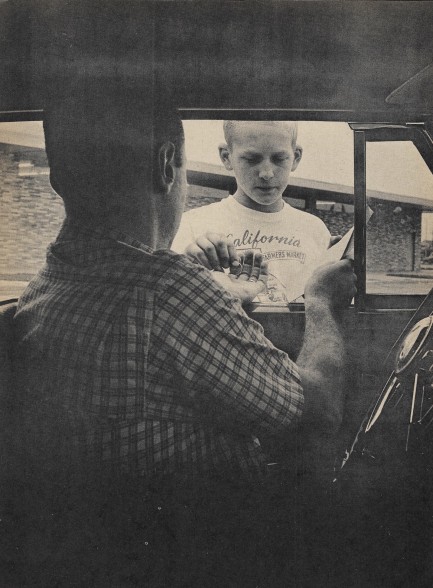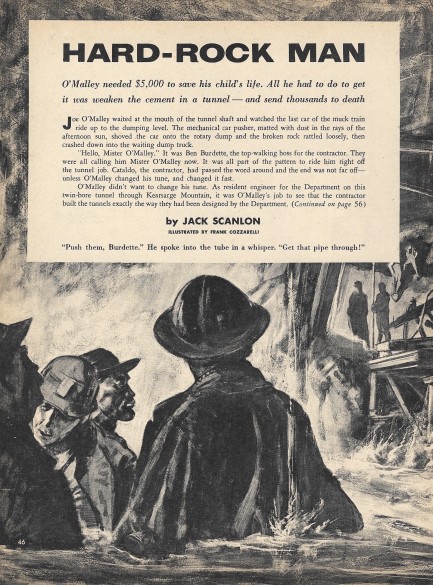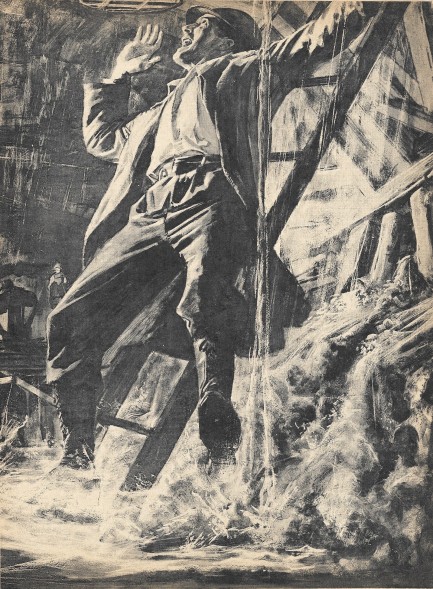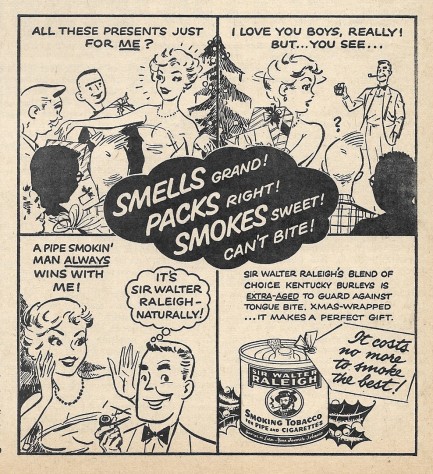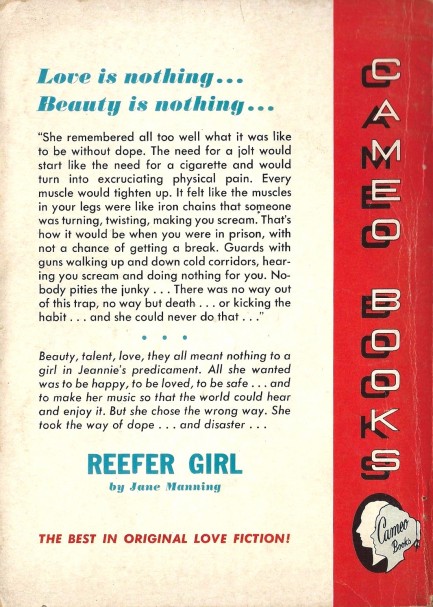 She never has unprotected sex. 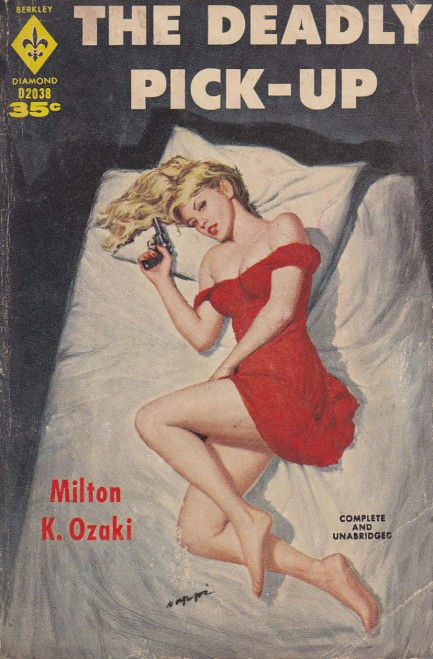
Above: an alternate cover for Milton K. Ozaki's 1952 thriller The Deadly Pick-Up. We use “thriller” loosely, because it wasn't a very involving book. But both covers are excellent. This one is by Rudy Nappi. You can see the other, by an uncredited artist, here.
 You say I'm beautiful now. But when you find out I have an unabsorbed twin attached to my abdomen you'll change your tune just like every man. 
Yup, it's Amos Hatter again. He makes yet another appearance here, this time with his 1952 carny novel Girl of the Midway. This was a natural: we love carny novels, and Hatter specializes in sleazy quasi-romances, which we also like. In this one a naive young woman named Margy Brophy, who works for her father's merry-go-round concession at an amusement park called Dreamland, gets involved with a man named Bill Tanner who plans to bring a big stage show onto the premises. The carnies fear the show will put some of their concessions out of business, so Margy's affair is an uncomfortable case of consorting with the enemy. However, Tanner has no intention of stealing customers. He tries but can't convince the carnies that, given time, his show will actually increase the patronage at their concessions. The battle lines harden, then the most recalcitrant of the carnies is murdered.
The homicide aspect of the book isn't much of a mystery. You merely have to look past the obvious red herring and choose the next most unpleasant carnival denizen, which you'll do automatically. But Hatter isn't a mystery writer anyway. His jam is sexual titillation, and though he does that reasonably well here, at this point we have to accept that he'll probably never again approach the heights of his Hawaii-based novel Island Girl. Of course, in general, you're not looking for nail-biting thrills, deep insight, or remarkable literary style with these types of books. They're meant to give you a semi-boner or three. There are no boners, semi or otherwise, caused by Girl of the Midway. But there's a good amount of carnival atmosphere, and that was enough for us to enjoy the book. Even so, we can't recommend it. We do, however, recommend that you appreciate the cover art by Rudy Nappi. It's perfection.
 All's affair in love and show business. 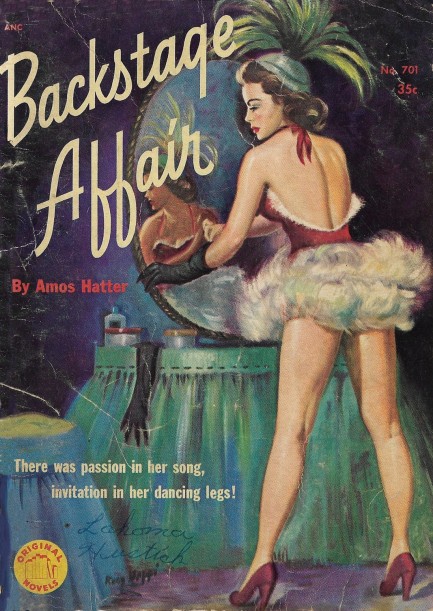
First matter—we met a couple of nice women at the gintoneria in one of our local plazas last night and said we'd mention them today as a way of proving that we were telling the truth about being the makers of this website. So hello, friends, and sorry about all the nudity you'll find here. Hah—well, not really. Anyway, last year we read Amos Hatter's (James W. Lampp's) unusual 1952 titillation novel Island Girl, and since we're repeat offenders when it comes to authors who intrigue us, we picked up another Hatter—1951's Backstage Affair. It's about a dancer and singer named Mitzi West who's trying earn her first big show business break, but is stuck in St. Louis finding it exceedingly difficult not to become a prostitute to support herself. By now you know the formula with these tales, so we don't need to explain the plot in more detail. It isn't as good as Island Girl, but it's enjoyable enough, and it came with Rudy Nappi cover art—signed by both him and a former owner of the book named Lahoma Hustich. Love your name, Lahoma.
 They can have her body but her heart's off limits. 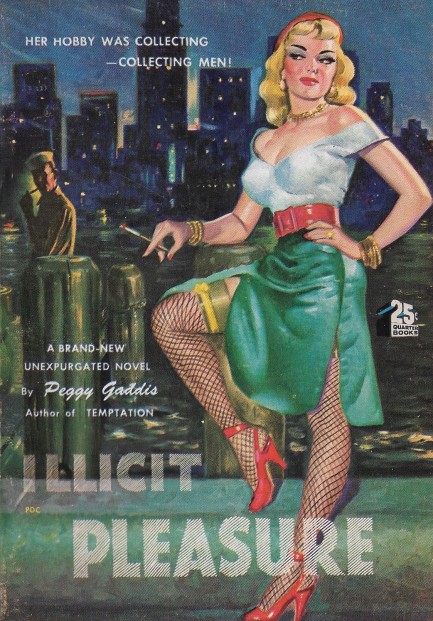
Digest sleaze novels are reflective of their time like all media tend to be. They often focus on “career women,” as they were called back then, female characters intent upon pursuing materialistic goals in the realm of white collar work. There are two types—those who intend to become successes in their fields, but at possible risk of their womanly souls, and those who intend to marry men who are already successes, but at possible risk of their virtue and reputation. These dilemmas come across as quaint nowadays, but back then ambitious white collar women were a subject of discussion and consternation. Their migration into the world of wage earning was a sign for many that America was going to hell in handbasket. At least that's what our reading shows. We weren't there.
In Peggy Gaddis's 1950 drama Illicit Pleasure the main character Linda Blaine becomes a secretary to a powerful executive. She's expected to type and file, but her most important job is to make the boss look good by being eye candy. When another top exec wants her for bed candy, Linda decides to sort through her options, and pretty soon she's cheating on her boyfriend, is involved with a married man, and all the rest. This is according to formula—the heroines of these novels generally have sex with three different men, though one of those encounters might be through emotional coercion or trickery. In this case, Linda hooks up with someone in pitch darkness, and doesn't realize until the lights go on that it wasn't the man she wanted, but rather the man she hates and who's trying to destroy her. Gaddis always wraps these messes up tidily, and does so here too. She's a solid genre writer, if melodramatic, and her romps are interesting windows into 1950s sexual mores.
The cover of this was painted by the always adept Rudy Nappi, and we think we've gotten hold of one of his best efforts. In addition, the book is in pristine condition. For that reason, we could scan only two of the interior photos, because to get the third would have meant breaking the binding. We do that with our old magazines when needed but Nappi is a special case, and we didn't want to damage this. Not that we plan to sell it. Print it and frame it? Maybe. So below you get two interior photos, the rear cover, and a nice upload of the original art. The title page of the book says Nappi painted it especially for Illicit Pleasure. Well, maybe, but Linda Blaine at no point haunts the waterfront like this somewhat prostie-looking figure, and she's a brunette, not a blonde. But never let the actual story get in the way of a good sales pitch. Women on docks was yet another extremely popular motif in vintage paperback art. See what we mean here, here, here, and here.
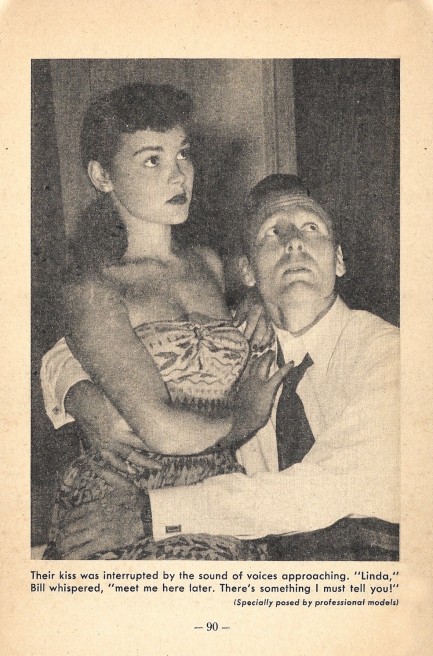 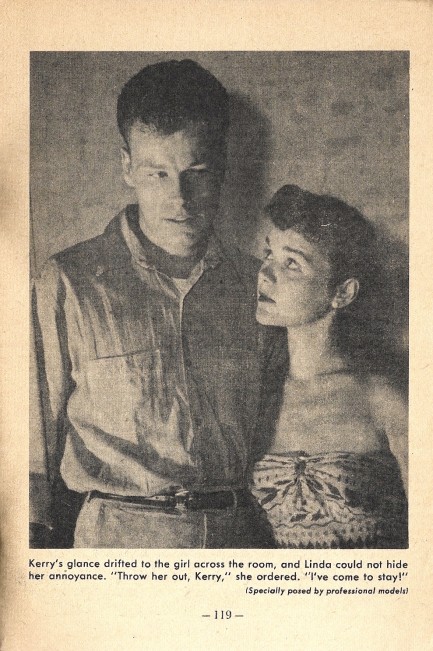 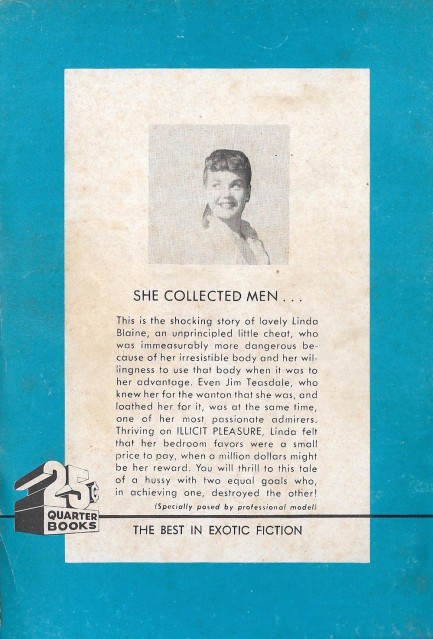 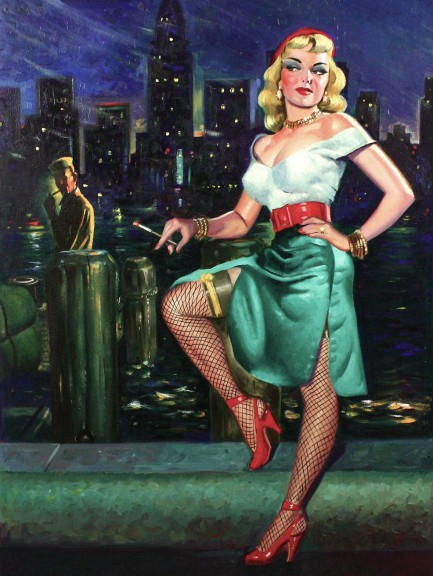
 Finally! I've been waiting here an eternity for a man who looks like a success. Wanna get married? 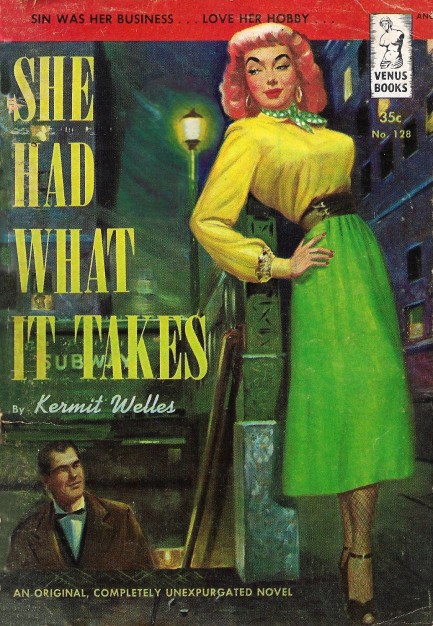
This cover for 1951's She Had What It Takes by Kermit Welles is uncredited but it was definitely painted by Rudy Nappi, an amazing stylist, whose work is not always immediately identifiable due to the variations he showed when painting femmes fatales. The bangs and heavy eyebrows you see on this one mark her as Nappi all the way, but often his work resembled that of George Gross and Howell Dodd. We've never seen a less-than-excellent cover from him, though, and this one is especially good.
The story deals with a smalltown journalist named Jan Flowers who wants to make it to NYC, have her own society column, and marry rich. She dumps her true love Tony Bennett (not that one), jets to the Big Apple, and promptly finds every worm. The worst of her problems is probably that the cousin she's living with is consorting with a local gangster who's always in the apartment giving Jan the eye and threatening to take her by force. Or maybe the worst of her problems is the blackmail scheme she gets involved in to advance her career. Or maybe it's the employer who wants to play slip and slide and makes Jan feel that if she does he'll open doors for her.
Well, take your choice. The point is New York is can be rough on a single girl. But She Had What It Takes, while being a drama and a quasi-crime novel and a morality play about what can happen when you ride the sell-your-soul train, is also largely a romance, and a particularly saccharine one, which means things won't end up too terribly no matter what kind of bonehead decisions Jan makes. Despite the lack of real suspense, overall the book was alright. Ultimately lightweight, but readable and reasonably fun. For what we paid, we can't complain.

 *sob* It gets so confusing when the sinful stuff is the most fun. 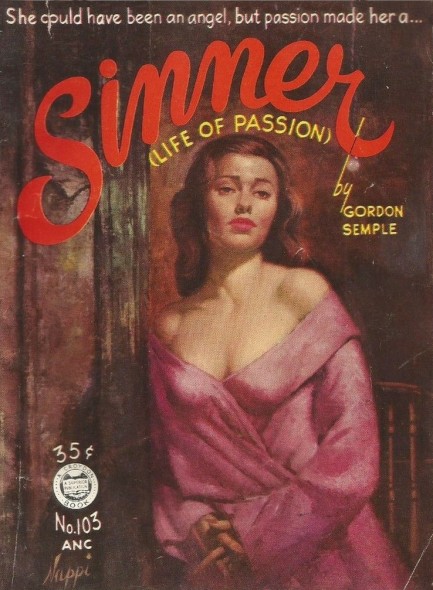
We love this melodramatic cover for Gordon Semple's Sinner. This was painted by Rudy Nappi, who most aficionados consider one of the best paperback illustrators of the mid-century period. He certainly had one of the longest careers. There are numerous works of his we don't have on this site, but the ones we've uploaded that we like best are here and here. Moving on to Gordon Semple, he was in reality William Neubauer, and wrote such sleaze novels as Love Crazy Millionaire, Blonde Temptress, and Man-Crazy Hussy. Sinner was originally titled Life of Passion, and was first published back in 1949. The above edition is from Croydon Books and hit newsstands in 1953. You can read the rear cover teaser below. 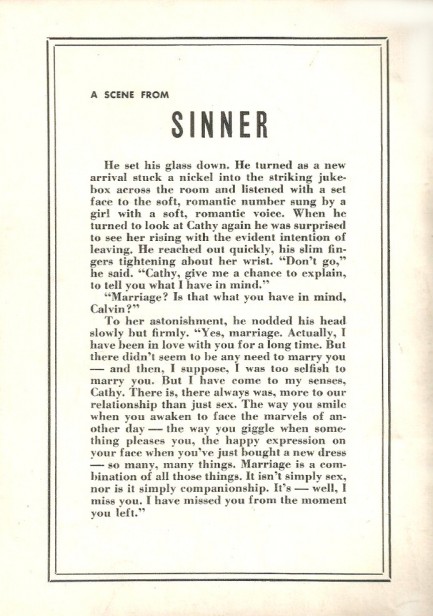
 He fell for her—hook, line, and sinker. 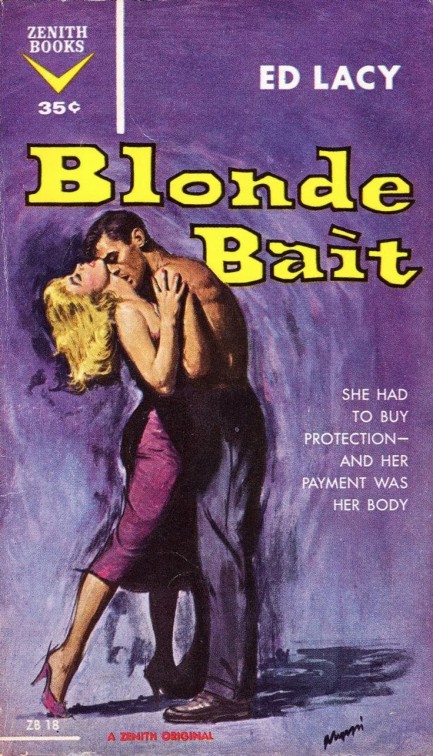
Above is a nice cover for Ed Lacy's Blonde Bait. We talked about Lacy recently—he was a white writer who lived much of his life in Harlem and wrote many black characters. Blonde Bait isn't one of those books. It's about a guy named Mickey who's sailing the Florida Keys on his yacht and comes across a woman stranded on a sand bar. Strangely, she has a suitcase. Her name is Rose, and how she got there, as well as what's in the bag, is what the book is all about. That and whether she's telling the truth about highly connected and dangerous men trying to kill her. Lacy wasn't a master stylist but for those who like books with boats, islands, and mysterious femmes fatales, this one will fit the bill. The art on this beautiful 1959 Zenith Books edition is by Rudy Nappi.
 Just let me out! I know a little about cars and I don't think that's what four-on-the-floor really is. 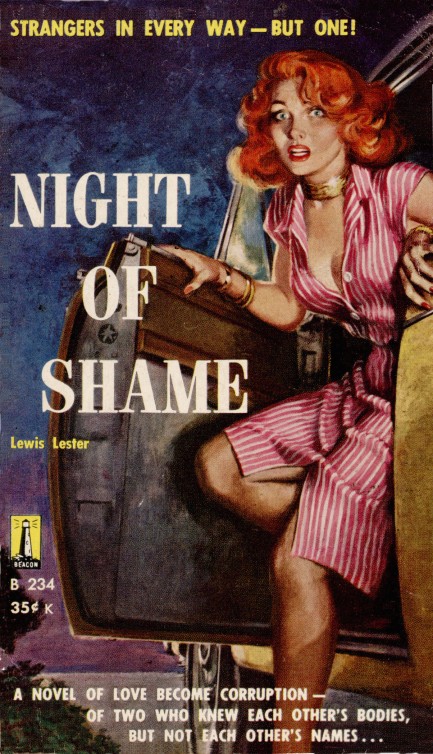
Four-on-the-floor. Too easy, right? What can we do? We're only human. 1959's Night of Shame deals with anonymous partners in a one night stand whose lives are complicated by their constant desire for each other. Later, they meet again by chance and rekindle their affair, only to discover, as Mr. Spock once so eloquently put it, that having is not so pleasing a thing after all as wanting. The beautiful cover on this is unattributed, but it could be Rudy Nappi. We reached that conclusion because it's very similar stylistically to this cover, which is identified as Nappi's work in Gary Lovisi's Dames, Dolls and Delinquents: A Collector's Guide to Sexy Pulp Fiction. Problem is, we don't actually think that cover is Nappi either. We think it's Howell Dodd. This wouldn't be the first time we've doubted Lovisi, but what do we know? We didn't write a whole book on the subject. So, okay, call this one Nappi.* *psst—it's Dodd.
 Next challenge—getting the potato chips from the kitchen without moving any part of my body. 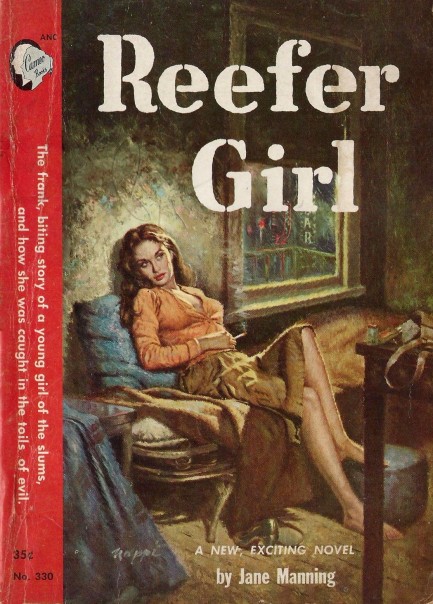
Reefer Girl is one of the most collectible vintage paperbacks in existence. How collectible? We saw someone selling it for $750, which is quite an ask, considering it was going for $125 just five years ago. Both prices are an awful lot of money for something that, if you leave it on a table for a few minutes, you might walk back into the room to find your girlfriend swatting a fly with it. We've uploaded the rear of the book below so you can see how funny author Jane Manning's, aka Ruth Manoff's take on weed is. The book was published in 1956, and here we are sixty-one years later having made the journey from marijuana being an object of total hysteria to it reaching legal status in multiple parts of the U.S. That's progess—for as long as it lasts, at least. The cover art here is by Rudy Nappi, and his stuff is always top quality.

|
 |

The headlines that mattered yesteryear.
2003—Hope Dies
Film legend Bob Hope dies of pneumonia two months after celebrating his 100th birthday. 1945—Churchill Given the Sack
In spite of admiring Winston Churchill as a great wartime leader, Britons elect
Clement Attlee the nation's new prime minister in a sweeping victory for the Labour Party over the Conservatives. 1952—Evita Peron Dies
Eva Duarte de Peron, aka Evita, wife of the president of the Argentine Republic, dies from cancer at age 33. Evita had brought the working classes into a position of political power never witnessed before, but was hated by the nation's powerful military class. She is lain to rest in Milan, Italy in a secret grave under a nun's name, but is eventually returned to Argentina for reburial beside her husband in 1974. 1943—Mussolini Calls It Quits
Italian dictator Benito Mussolini steps down as head of the armed forces and the government. It soon becomes clear that Il Duce did not relinquish power voluntarily, but was forced to resign after former Fascist colleagues turned against him. He is later installed by Germany as leader of the Italian Social Republic in the north of the country, but is killed by partisans in 1945.
|

|
|

It's easy. We have an uploader that makes it a snap. Use it to submit your art, text, header, and subhead. Your post can be funny, serious, or anything in between, as long as it's vintage pulp. You'll get a byline and experience the fleeting pride of free authorship. We'll edit your post for typos, but the rest is up to you. Click here to give us your best shot.

|
|



















